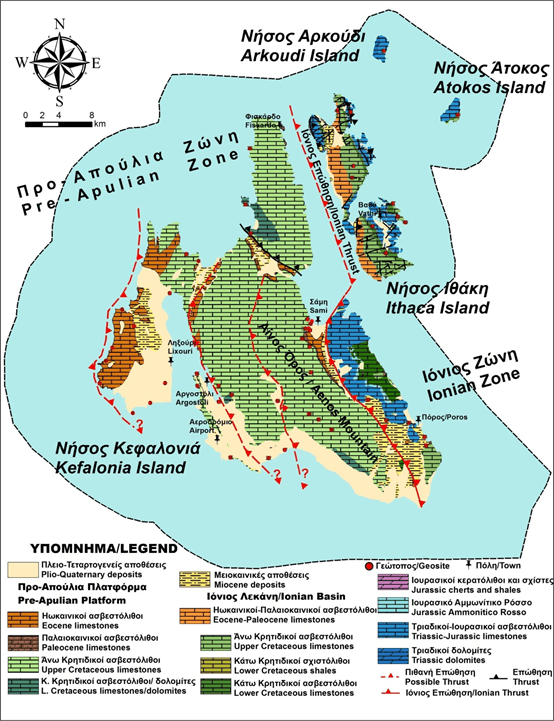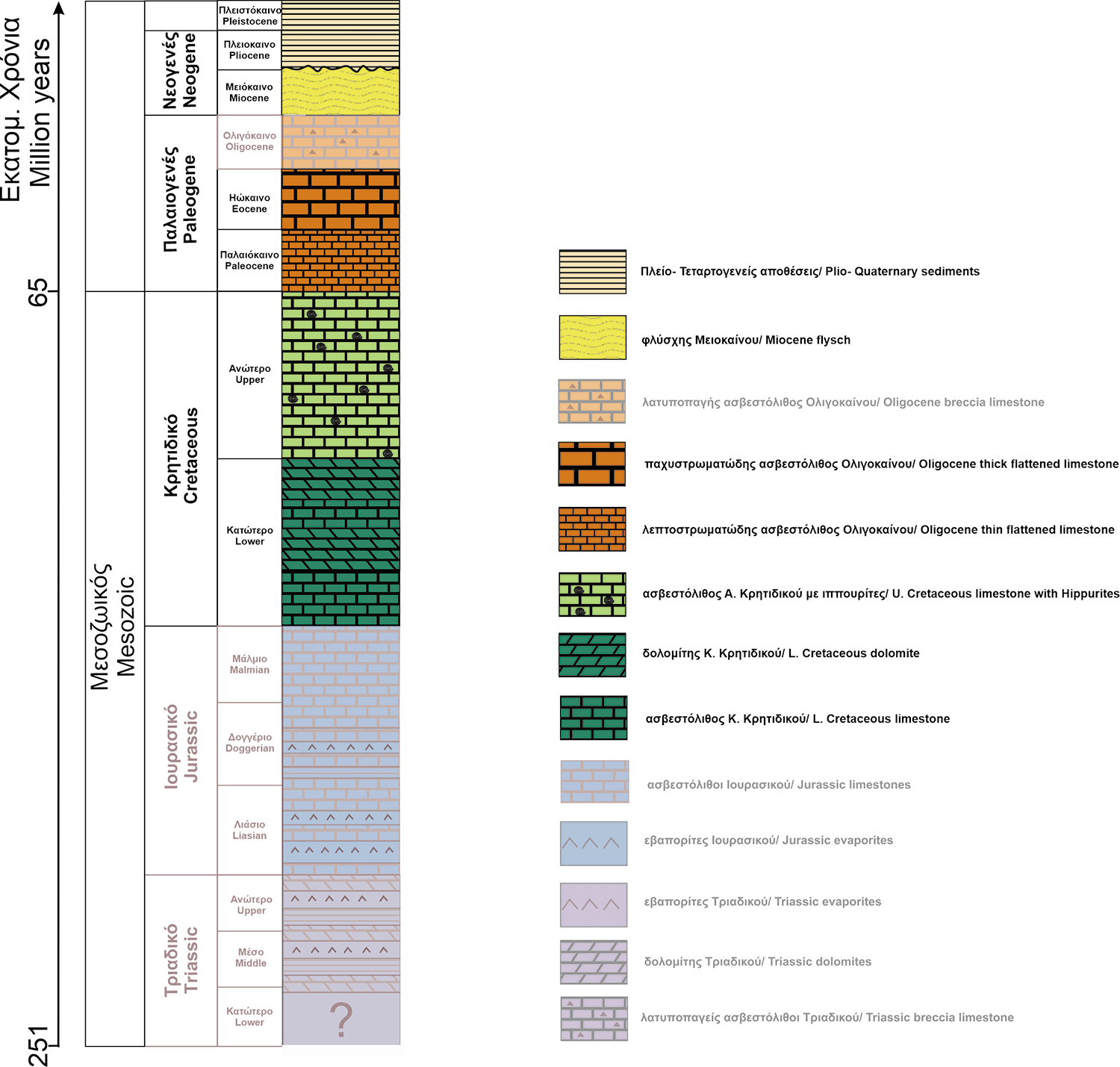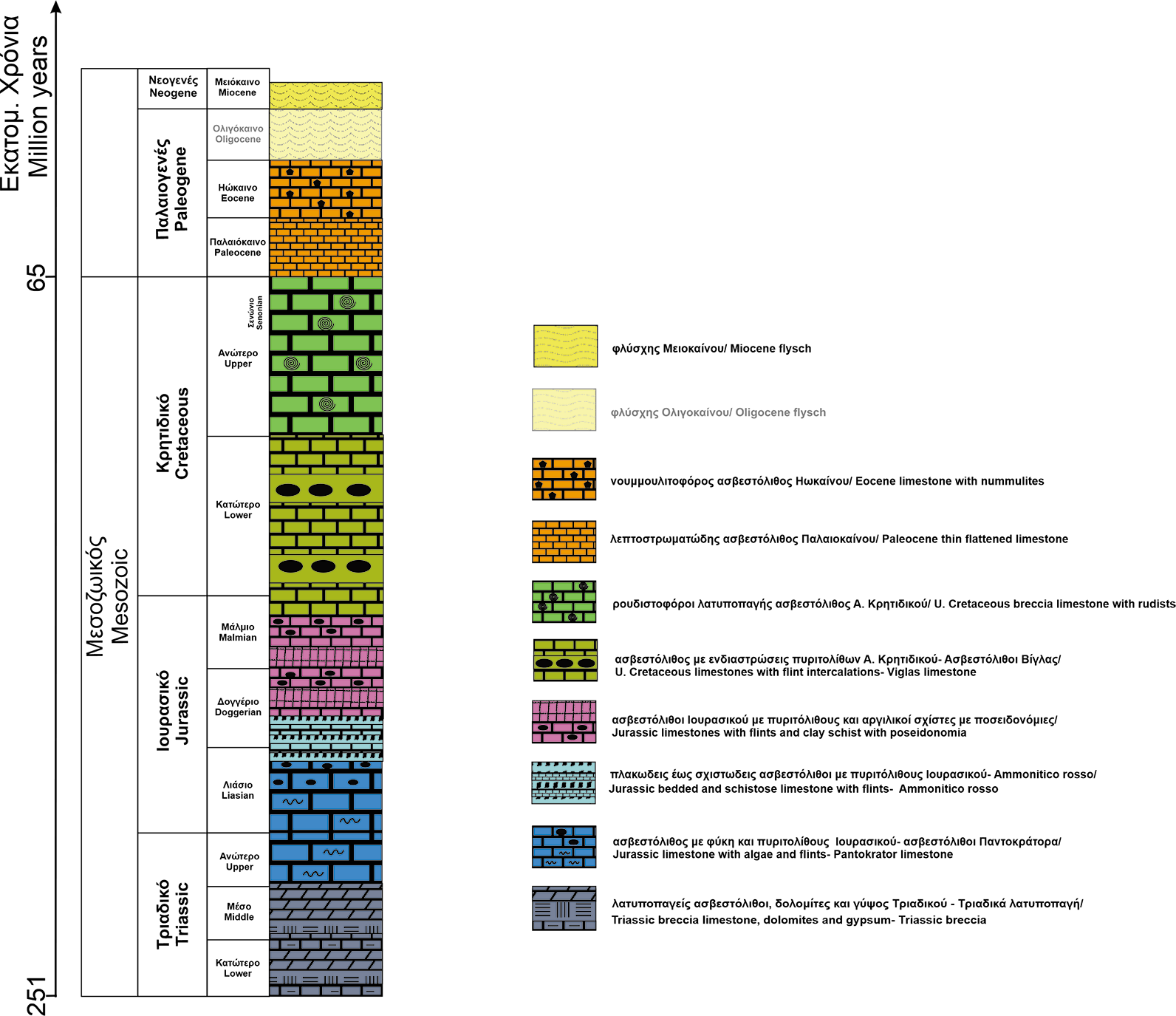250 million years ago, at the end of the Paleozoic era, the continental surface of the earth was a single supercontinent, Pangea, which was surrounded by the superocean system basins of Panthalassa. This was followed by the breakage of Pangea into tectonic plates that sometimes move away and sometimes collide in order to form the continents in their current form. From the initial breakage of the Pangea 200 million years ago, the ocean of Tethys was formed.

The rocks we find in Greece today were formed at the bottom of Tethys. Subsequently, from the submersion of the Tethys Ocean and the collision of the Eurasian and African tectonic plates, the geotectonic zones of Greece merged the External and Internal Hellenides. Hence, the Mediterranean Sea constitutes a remnant of the Tethys Ocean.
Kefalonia and Ithaca Islands consist the westernmost part of External Hellenides. They are located very close to the Greek arc, which is the most tectonically active region in Europe. Due to their geotectonic position, the islands present rich geology and great seismic activity, on which we find an excellent depiction of the dynamics of terrestrial processes, through the numerous and wide variety of geological features.
An additional characteristic of these two islands is that most of their surface is covered by limestone. This fact in combination with the tectonic activity, the climatic conditions and the processes of erosion and deposition results in the appearance of numerous underground and surface karstic geomorphs such as caves, valleys, sinkholes, bays, forms of surface erosion etc. Therefore, such processes form a rich karstic system mainly in the area of Sami but also all over the carbonate rocks on both islands, but to a lesser extent.
Of particular interest is the fact that part of the karstic network is located below sea level, causing global interest not only due to the rich speleothems such as stalactites and stalagmites, but also for its extent. This peculiarity is caused by submersion due to intense tectonism but also due to the sea level rise caused by the melting of the last glaciers resulting in the flooding of many of Kefalonia caves.
The geological structure of Kefalonia consists of two different geotectonic zones (alpine formations) of the External Hellenides, with an overall NNW-SSE orientation. The Pre-Apulian or Paxos zone in the west which is relatively indigenous and covers most part of the island (483.4 Km2) and the Ionian zone which appears in the southeastern part of the island in a smaller area (68.72 Km2), which is thrusted over the previous one.
The front of this thrust with a NNW-SSE orientation passes through the NW end of Ithaca and the SE part of Kefalonia. In addition Plioquaternary formations (post-Alpine orogeny formation) can be identified, which settle unconformably on the older ones. Respectively, the island of Ithaca is built almost exclusively by the Ionian zone, and mainly by the Ionian carbonate series deposited between the Jurassic (201 - 145 My) - Eocene (56-33.9 My). The Ionian zone on Ithaca is completed with the Oligocene-Middle Miocene flysh (33.9-13.82 My) (Figure 1).
The Pre-Apulian or Paxos zone (Figure 2) is the most external zone of the External Hellenides and it is considered that it constitutes the easternmost part of the Apulian plate which extends to the southeastern edge of the Italian peninsula. The Pre-Apulia zone of the Kefalonia island is characterized by a continuous sequence of neritic carbonate rocks (dolomites, limestones, marly limestones), with its deposition starting at the Lower Cretaceous (145-100.5 My) and developing until the Upper Miocene (12-5.332My).
Specifically, the lithological formations that occur in the Pre-Apulian zone starting from the oldest, consist of the Lower Cretaceous formation (145-100.5 My) which occupies a small but important area, as it occurs only on the island of Kefalonia. It is distinctive that these rocks are the oldest ones of the Pre-Apulian zone found on the surface of the island and consist of dolomites and limestones.
This is followed by the formation of the Upper Cretaceous (100.5-66 My) made of strongly fractured and karstified white limestones, rich in fossils of sea organisms such as Hippurites, which have the largest distribution on the island. Subsequently, the formation of the Paleocene (66.5-56 My) occurs consisting of thin-layered pelagic limestones, followed by the formation of the Eocene (56-33.9 My) consisting of unbedded or thick-bedded neritic limestones, which contain large Foraminifera, and which in Kefalonia is located stratigraphically conformably on top of the formations of the Cretaceous (145-66 My).
Finally, the Pre-Apulian zone concludes with the Miocene formation (23.03-5.332 My),made of marly sediments, often sandstones, alternating with brecciated limestones, which replace the typical clastic sediments of the other geotectonic zones.

The Ionian zone (Figure 3) on the island of Kefalonia occurs in a much smaller area, in contrast to Ithaca, where it covers the entire island. Specifically in Kefalonia it appears only in the southeastern part of the island and is thrusted, as we have mentioned above, over the Paxos zone. From all the lithological formations of the Ionian zone in the two islands occur mainly limestones from the Jurassic (201.3-145 My) to the Eocene (56-33.9 My) as well as Triassic evaporites (251. 2-201.3 My) age.
Specifically, the oldest formations of the Ionian zone are Triassic "Breccia”, which is a mixture of brecciated limestones, dolomites and gypsum. Above them occurs a carbonate sequence of Upper Triassic (230-201 My) Middle Lias (190-183 My), which includes massive, light-colored, thick-bedded limestones with fossil algae, and limestones with cherts, corresponding to the neritic" Pantocrator Formation".
This formation covers a major part of the area in relation to the other formations of the Ionian zone. The subsequent formation is the Ammonitico rosso of Upper Lias-Lower Dogger (approximately 183-170 My). These mainly consist of red thin-bedded, partly platy limestones with thin marl intercalations, containing Toarsian Ammonites (183-174 My) aged. Then limestones with cherts and clay shales with “Posidonia” of Middle Dogger-Malmio age (174-145 My) follow.
The Jurassic-Cretaceous formations (201.3-100.5 My) are represented by the well-bedded pelagic limestones of Vigla, which alternate with layers of cherts. Respectively, the Upper Cretaceous (100.5-66 My) is represented by massive rudist bearing brecciated limestones. We continue with the Paleocene formation (66.5-56 My), which consists of fine-grained limestones, followed by the Eocene (56-33.9 My) which is represented by unbedded nummulite bearing marly limestones. And the Ionian zone is completed with the occurrence of the Oligocene-Middle-Miocene flysh formation (33.9-13.82 My).
The geological structure of Kefalonia and Ithaca islands is completed with the post-Alpine orogeny formation which consist of Pliocene marls (5,333- 2.58 My), as well as with the Quaternary (2,588 My until now) marine sediments and terrestrial formations.
